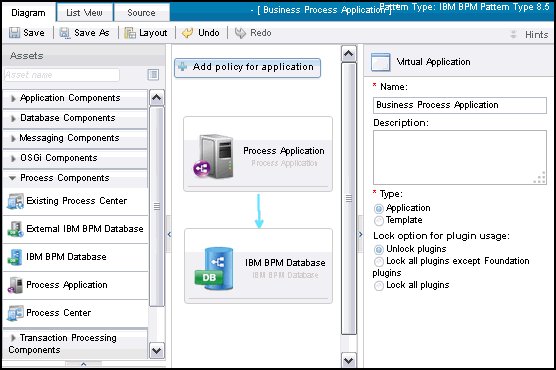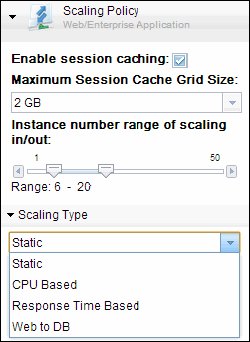Abstract
Using patterns and the integrated expertise built into virtual application patterns provided by IBM® can help your organization achieve accelerated time to value and higher hardware utilization rates. This IBM Redbooks® Solution Guide can help you gain the agility to meet the demands of business through automatic scaling policies, service level agreements (SLAs), and quality of service (QoS) settings for the virtual application. Also, complicated topologies that used to take months to deploy, can now be deployed within hours using IBM PureApplication™ System. Figure 1 shows the Business Process Manager Virtual Application pattern. The virtual application will handle topology decisions according to SLA and QoS definitions the operator provides at deployment. This leaves the operator to be concerned only about the application level at deployment, because the virtual application handles scaling, application server clustering, and so on.
Contents
Using patterns and the integrated expertise built into virtual application patterns provided by IBM® can help your organization achieve accelerated time to value and higher hardware utilization rates. This IBM Redbooks® Solution Guide can help you gain the agility to meet the demands of business through automatic scaling policies, service level agreements (SLAs), and quality of service (QoS) settings for the virtual application. Also, complicated topologies that used to take months to deploy, can now be deployed within hours using IBM PureApplication™ System. Figure 1 shows the Business Process Manager (BPM) Virtual Application pattern. The virtual application will handle topology decisions according to SLA and QoS definitions the operator provides at deployment. This leaves the operator to be concerned only about the application level at deployment, because the virtual application handles scaling, application server clustering, and so on.

Figure 1. The Virtual Application Builder view of the BPM pattern
Did you know?
Patterns offer enterprises the ability to rapidly deploy complex topologies with high fidelity and repeatability. What used to take four to six months by teams of information technology (IT) experts can now be realized and used in a single afternoon by a single pattern deployer. This, however, does take some preparation and configuration. The steps for successful pattern deployment described later in this document are applicable to the w1500 model of IBM PureApplication System.
Business value
The IBM provided Virtual Application pattern is used for business process management but you can also create our own plug-ins and pattern types to create a virtual application pattern tailored to your needs for any application workload. Several aspects of virtual application patterns can add value:
You might ask yourself “Why bother? I can just use the tools and scripts I always have used.” While this statement is true, it is ignoring the real value of patterns and the integrated expertise built into the patterns provided by IBM provided. Traditionally, over 30% of all application server rollouts fail on their initial trial run, which in the case of Business Process Manager requires the following items:
This results in wasting vast amounts of time and manpower. Teams of experts that deployed the failing instance must go through a diagnostic phase to determine the deployment failure before they can even begin to attempt another build rollout. The time sink and loss of agility for the business can be significant. Often there are small differences in every cluster or cell that prevent automated management without considerable investment in maintaining the code to perform these steps. The patterns provided by IBM uses the integrated expertise from IBM teams that specialize in those services and assures the same deployment and configuration every time a cluster or cell is deployed.
Solution overview
The IBM Business Process Manager Pattern Type contains the plug-ins that you need to deploy an Advanced Cluster for the Business Process Manager. After the pattern type is installed and the license accepted, the pattern type will be listed in the pattern types menu, under the Cloud tab (Figure 2).

Figure 2. BPM Pattern Type from the IBM PureApplication System dashboard
With an application as complex as Business Process Manager, the task to set up and configure, even for an expert, can be daunting. The Business Process Manager pattern can ease this by offering these items:
Development teams can take control of their development cycles and begin to engage in DevOps activities, such as continuous or rapid regression testing, without having to be tied to a cluster or set of clusters. Each test environment can repeatedly be returned to a known re-entrant state and thus eliminate common debug cycles in a traditional environment. Traditionally many hours can be spent chasing down what is essentially a misconfiguration issue, which is not a real bug. Also, new development can take advantage of how easily configuration can be changed by using the Virtual Application Builder (VAB) and explore new configurations for a fraction of cost and investment of a traditionally deployed cluster. Best of all, after the work or exploration is complete, the virtual application can be disposed of to allow the reassignment of the resources to other projects. This can help maintain a high hardware utilization rate, because using or not using resources as needed is easy. No more servers hiding under desks doing nothing. The reporting features offer methods of charge-back in the organization, and the monitoring features give the ability for administrators to see what user or group is using which resource in real time or historical contexts.
Solution architecture
The IBM Business Process Manager Virtual Application does not focus on specific topologies or layout for clusters as a traditional deployment would. Instead, it monitors the virtual application CPU usage, application layer latency, or database to web latency, and scales the cluster according to the SLAs and the QoS settings that were defined in the VAB at deployment time. There are no real architecture and topology layout concerns. The integrated expertise of the pattern will instantiate and remove virtual machines (VMs) from the cluster or cell as needed to fulfill the SLAs set in the VAB. Figure 3 shows a sample scaling SLA and QoS.

Figure 3. Sample scaling policy, SLA, and QoS
Usage scenarios
The IBM provided patterns have the value of integrated expertise from teams of IBM experts. Patterns can also help drive standardization in organizations attempting to gain control of configuration drift or misconfiguration debugging issues. The repeatability provided by the patterns ensures that newly dispensed applications will all be similar in configuration. There are several ways organizations can utilize the power and ease of use of the IBM Business Process Manager Virtual Application:
The steps to follow for a deployment are fairly simple:
Integration
After the pattern is deployed, the console for the Process Center can be managed as any other Process Center or Process Server. Integration of the deployed pattern into the data center can be achieved as it normally is by mapping resources either through the wsadmin tool of the IBM WebSphere® cluster directly or by the Process Center or Process Server consoles. The Business Process Manager pattern can be integrated into the following services:
Supported platforms
The IBM Business Process Manager Virtual Application pattern is supported on the x86 (w1500) model. Virtual applications in general are architecture agnostic by nature.
Ordering information
Table 1. Ordering program number
Related information
For more information, see the following documents:

Figure 1. The Virtual Application Builder view of the BPM pattern
Did you know?
Patterns offer enterprises the ability to rapidly deploy complex topologies with high fidelity and repeatability. What used to take four to six months by teams of information technology (IT) experts can now be realized and used in a single afternoon by a single pattern deployer. This, however, does take some preparation and configuration. The steps for successful pattern deployment described later in this document are applicable to the w1500 model of IBM PureApplication System.
Business value
The IBM provided Virtual Application pattern is used for business process management but you can also create our own plug-ins and pattern types to create a virtual application pattern tailored to your needs for any application workload. Several aspects of virtual application patterns can add value:
- Agility: With the use of virtual application patterns, businesses can gain the ability to quickly and efficiently reassign compute assets as business needs and SLAs change.
- Repeatability: When applications are dispensed through patterns, repeatability is assured and the information is retained in the pattern as institutional memory that is Intellectual Property of the business, not the individual. That way when employees get promoted, leave the company, or otherwise move to other opportunities, the knowledge is not lost and the skill transfer period is shortened.
- Integrated expertise: IBM provided patterns have teams of experts that work on the products contained in the pattern who donate their thoughts and experiences to the patterns. This expertise is built in and commonly referred to as integrated expertise. This frees the pattern deployer from being an expert in those areas.
- Accelerated time to value: Traditionally, data centers have seen instantiation times on a single application server cluster deployment measured in months. Using patterns can take that lead time from months to hours.
You might ask yourself “Why bother? I can just use the tools and scripts I always have used.” While this statement is true, it is ignoring the real value of patterns and the integrated expertise built into the patterns provided by IBM provided. Traditionally, over 30% of all application server rollouts fail on their initial trial run, which in the case of Business Process Manager requires the following items:
- A full uninstall
- A file system cleanup all the way to the operating system level
- A full database redeployment
This results in wasting vast amounts of time and manpower. Teams of experts that deployed the failing instance must go through a diagnostic phase to determine the deployment failure before they can even begin to attempt another build rollout. The time sink and loss of agility for the business can be significant. Often there are small differences in every cluster or cell that prevent automated management without considerable investment in maintaining the code to perform these steps. The patterns provided by IBM uses the integrated expertise from IBM teams that specialize in those services and assures the same deployment and configuration every time a cluster or cell is deployed.
Solution overview
The IBM Business Process Manager Pattern Type contains the plug-ins that you need to deploy an Advanced Cluster for the Business Process Manager. After the pattern type is installed and the license accepted, the pattern type will be listed in the pattern types menu, under the Cloud tab (Figure 2).
Figure 2. BPM Pattern Type from the IBM PureApplication System dashboard
With an application as complex as Business Process Manager, the task to set up and configure, even for an expert, can be daunting. The Business Process Manager pattern can ease this by offering these items:
- The integrated expertise of the IBM Business Process Management team
- Assured repeatability of configuration
- Scalability of the cluster
Development teams can take control of their development cycles and begin to engage in DevOps activities, such as continuous or rapid regression testing, without having to be tied to a cluster or set of clusters. Each test environment can repeatedly be returned to a known re-entrant state and thus eliminate common debug cycles in a traditional environment. Traditionally many hours can be spent chasing down what is essentially a misconfiguration issue, which is not a real bug. Also, new development can take advantage of how easily configuration can be changed by using the Virtual Application Builder (VAB) and explore new configurations for a fraction of cost and investment of a traditionally deployed cluster. Best of all, after the work or exploration is complete, the virtual application can be disposed of to allow the reassignment of the resources to other projects. This can help maintain a high hardware utilization rate, because using or not using resources as needed is easy. No more servers hiding under desks doing nothing. The reporting features offer methods of charge-back in the organization, and the monitoring features give the ability for administrators to see what user or group is using which resource in real time or historical contexts.
Solution architecture
The IBM Business Process Manager Virtual Application does not focus on specific topologies or layout for clusters as a traditional deployment would. Instead, it monitors the virtual application CPU usage, application layer latency, or database to web latency, and scales the cluster according to the SLAs and the QoS settings that were defined in the VAB at deployment time. There are no real architecture and topology layout concerns. The integrated expertise of the pattern will instantiate and remove virtual machines (VMs) from the cluster or cell as needed to fulfill the SLAs set in the VAB. Figure 3 shows a sample scaling SLA and QoS.

Figure 3. Sample scaling policy, SLA, and QoS
Usage scenarios
The IBM provided patterns have the value of integrated expertise from teams of IBM experts. Patterns can also help drive standardization in organizations attempting to gain control of configuration drift or misconfiguration debugging issues. The repeatability provided by the patterns ensures that newly dispensed applications will all be similar in configuration. There are several ways organizations can utilize the power and ease of use of the IBM Business Process Manager Virtual Application:
- Because there can be a production and a non-production QoS setting, development teams can deploy their own environments and shut them down when done without needing to have a full production cluster. In this way, testing and exploratory development are literally at the developers fingertips.
- Conversely, the operations team can use the pattern to reliably and repeatedly dispense production level environments and set the QoS in such a way as to meet the SLA in a highly available fashion. The virtual application will monitor and adjust itself as needed, and the cluster will gain and lose members.
- The pattern can use off-platform databases or the database as a service (DBaaS) aspects of the PureApplication System.
- Solution architects can design patterns and control configuration through the use of infrastructure as code.
The steps to follow for a deployment are fairly simple:
- Acquire the pattern.
- Make the architectural decisions of what data center services the virtual application will need access to (load balancer, IBM DataPower®, remote databases or DBaaS, remote monitoring, and so on).
- Prepare the prerequisites (prepare remote databases, configure DBaaS and create the Database Workload Standard, prepare LDAP, and so on).
- Upload the pattern to the PureApplication System.
- Create a pattern in the VAB from a template or use the blank pattern from the Business Process Manager Pattern type.
- Edit the pattern to reflect the architectural decisions from step two (database port, database name, database user names, LDAP specifics, and so on).
- Deploy the virtual application, which will have links to the Process Center and Server endpoints after the deployment successfully complete, which might take an hour or so.
- Log in to your virtual application and configure it as normal.
- Use your newly deployed and configured virtual application.
Integration
After the pattern is deployed, the console for the Process Center can be managed as any other Process Center or Process Server. Integration of the deployed pattern into the data center can be achieved as it normally is by mapping resources either through the wsadmin tool of the IBM WebSphere® cluster directly or by the Process Center or Process Server consoles. The Business Process Manager pattern can be integrated into the following services:
- Remote IBM DB2® or Oracle databases
- Remote LDAP services
- Remote IBM Tivoli® Monitoring
- DBaaS from PureApplication or IBM PureData™ System
- Other Virtual Applications deployed by PureApplication System
Supported platforms
The IBM Business Process Manager Virtual Application pattern is supported on the x86 (w1500) model. Virtual applications in general are architecture agnostic by nature.
Ordering information
This product is only available through IBM Passport Advantage®. Contact your WebSphere salesperson or organizational Passport Advantage representative.
Ordering information is shown in Table 1.
Table 1. Ordering program number
Description | Program number | Charge metric |
IBM Business Process Manager Pattern v8.5 | 5725-L40 | PVU based |
Related information
For more information, see the following documents:
- IBM Offering Information page (to search on announcement letters, sales manuals, or both):
- Creating Composite Application Pattern Models for IBM PureApplication System, SG24-8146
- Adopting IBM PureApplication System V1.0, SG24-8113
- IBM Announcement Letter: IBM Business Process Manager Application Pattern V8.5 enables elastic business process scaling for your private cloud
- IBM PureApplication System product page
http://www.ibm.com/common/ssi/index.wss?request_locale=en
On this page, enter IBM Business Process Manager Pattern, select the information type, and then click Search. On the next page, narrow your search results by geography and language.
http://www.redbooks.ibm.com/abstracts/sg248146.html
http://www.redbooks.ibm.com/abstracts/sg248113.html
http://www.ibm.com/ibm/puresystems/us/en/pf_pureapplication.html
Others who read this also read
Special Notices
The material included in this document is in DRAFT form and is provided 'as is' without warranty of any kind. IBM is not responsible for the accuracy or completeness of the material, and may update the document at any time. The final, published document may not include any, or all, of the material included herein. Client assumes all risks associated with Client's use of this document.
